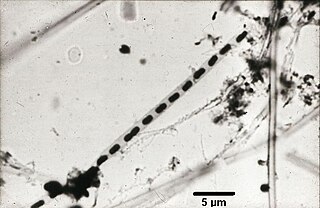Related Research Articles

The Comamonadaceae are a family of the Betaproteobacteria. Like all Pseudomonadota, they are Gram-negative. They are aerobic and most of the species are motile via flagella. The cells are curved rod-shaped.

The Pasteurellaceae comprise a large family of Gram-negative bacteria. Most members live as commensals on mucosal surfaces of birds and mammals, especially in the upper respiratory tract. Pasteurellaceae are typically rod-shaped, and are a notable group of facultative anaerobes. Their biochemical characteristics can be distinguished from the related Enterobacteriaceae by the presence of oxidase, and from most other similar bacteria by the absence of flagella.
Singulisphaera is a moderately acidophilic and mesophilic genus of bacteria from the family of Planctomycetaceae.
Desulforhopalus is a Gram-negative, strictly anaerobic, and non-motile genus of bacteria from the family of Desulfobulbaceae.
Proteiniphilum is a Gram-negative, obligately anaerobic, proteolytic and chemoorganotrophic genus from the family of Dysgonomonadaceae.
Thermanaerovibrio is a Gram-negative, non-spore-forming chemoorganotrophic and thermophilic genus of bacteria from the family of Synergistaceae.
Terrimonas is a Gram-negative, aerobic and non-motile genus of bacteria from the family of Chitinophagaceae.
Halorhodospira is a Gram-negative genus of bacteria from the family of Ectothiorhodospiraceae. Halorhodospira bacteria occur in hypersaline and extreme saline habitats.
Halochromatium is a Gram-positive and motile genus of bacteria from the family of Chromatiaceae. Halochromatium bacteria occur in microbial mats from hypersaline habitates.
Imhoffiella is a phototrophic genus of bacteria from the family of Chromatiaceae. Imhoffiella is named after the German microbiologist Johannes F. Imhoff.
Lamprobacter is a Gram-negative, rod-shaped and motile genus of bacteria from the family of Chromatiaceae with one known species. The habitat of Lamprobacter bacteria is hydrogen sulfide-containing mud and saline water.
Pararheinheimera is a genus of bacteria from the family of Chromatiaceae.
Phaeobacterium is a Gram-negative, rod-shaped, phototrophic and motile genus of bacteria from the family of Chromatiaceae with one known species.
Thiobaca is a phototrophic and motile genus of bacteria from the family of Chromatiaceae with one known species. Thiobaca trueperi has been isolated from sediments from a eutrophic lake.
Thiococcus is a Gram-negative, non‐motile, obligately phototrophic and strictly anaerobic genus of bacteria from the family of Chromatiaceae with one known species. Thiococcus pfennigii was first isolated from salt marshes.
Thioflavicoccus is a Gram-negative, obligately phototrophic, strictly anaerobic and motile genus of bacteria from the family of Chromatiaceae with one known species.
Thiohalocapsa is a Gram-negative and non-motile genus of bacteria from the family of Chromatiaceae.
Thiorhodococcus is a Gram-negative genus of bacteria from the family of Chromatiaceae.
Thiorhodovibrio is a Gram-negative genus of bacteria from the family of Chromatiaceae.
Cerasicoccus is a Gram-negative, non-motile, obligately aerobic and chemoheterotrophic bacterial genus from the family Puniceicoccaceae.
References
- 1 2 3 4 "Isochromatium". LPSN .
- ↑ Parker, Charles Thomas; Wigley, Sarah; Garrity, George M (11 May 2009). Parker, Charles Thomas; Garrity, George M (eds.). "Taxonomic Abstract for the genera". NamesforLife, LLC. doi:10.1601/tx.2097.
{{cite journal}}: Cite journal requires|journal=(help) - ↑ "Isochromatium". www.uniprot.org.
- ↑ Brenner, Don J.; Krieg, Noel R.; Staley, James R. (2007). Bergey's Manual® of Systematic Bacteriology: Volume 2: The Proteobacteria, Part B: The Gammaproteobacteria. Springer Science & Business Media. ISBN 9780387280226.